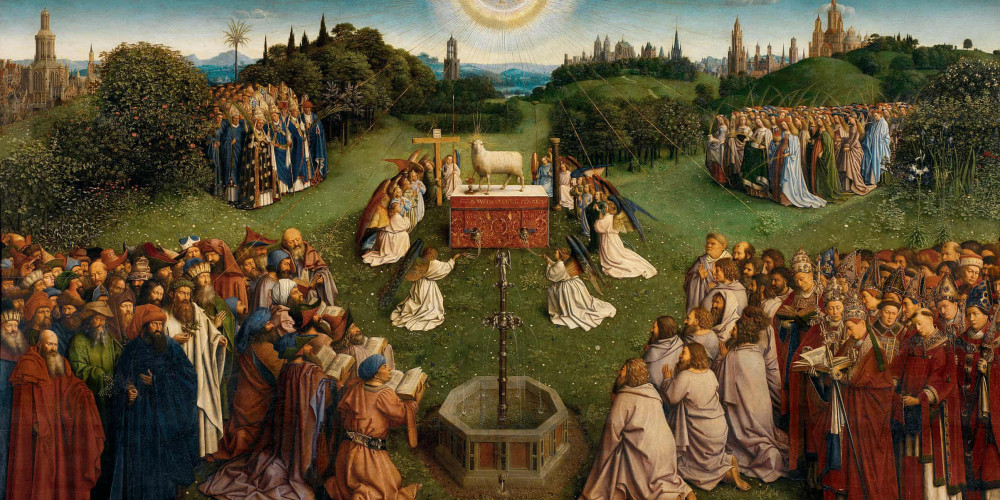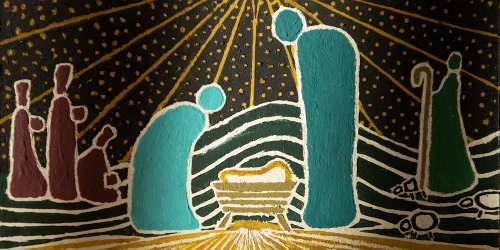“And the Word became flesh and dwelt among us, and we have seen his glory, glory as of the only Son from the Father, full of grace and truth.” John 1:14 Hymn Story At the time of Christ’s birth, the...

"Holy, holy, holy is the LORD God Almighty, who was, and is, and is to come!" - Revelation 4:8
Hymn Story
Reginald Heber was an ardent missionary and hymn-writer during the early 19th century. He wanted to compile a hymnal organized around the church calendar, with hymns assigned to particular services and paired with complementary Scripture readings. He wrote the lyrics to Holy, Holy, Holy for Trinity Sunday, which is the first Sunday after Pentecost; a day devoted to celebrating the Christian doctrine of the trinity. The Church of England’s Book of Common Prayer prescribed the reading of Revelation 4 for this day, which became the basis for Huber’s words.
Unfortunately, at the young age of 43 — just three years after accepting the post of Bishop of Calcutta, India — he died without ever seeing his desired hymnbook come to fruition. After his death, his wife found the lyrics to “Holy, Holy, Holy” scrawled among his papers. She published it a year later, along with 56 other hymn texts.
Decades later, a publisher rediscovered Heber’s work. He loved “Holy, Holy, Holy”, and asked John Bacchus Dykes to compose a melody to accompany the brilliant lyrics. It took him only thirty minutes to write the tune we know today, which Dykes named NICAEA, after the Council of Nicaea, which formulated the doctrine of the Trinity in A.D. 325. The lyrics and tune we know today were first published together in 1861 in the hymnal, Hymns Ancient and Modern. The famous British poet Alfred, Lord Tennyson called it the world’s greatest hymn.
Here is the Norton Hall Band singing “Holy, Holy, Holy”:
Lyrics
Holy, holy, holy! Lord God Almighty!
Early in the morning our song shall rise to Thee:
Holy, holy, holy! merciful and mighty!
God in Three Persons, blessed Trinity.
Holy, holy, holy! All the saints adore Thee,
Casting down their golden crowns around the glassy sea;
Cherubim and seraphim falling down before Thee,
Who wert, and art, and evermore shalt be.
Holy, holy, holy! though the darkness hide Thee,
Though the eye of sinful man Thy glory may not see,
Only Thou art holy; there is none beside Thee,
Perfect in power, in love, and purity.
Holy, holy, holy! Lord God Almighty!
All Thy works shall praise Thy Name, in earth and sky and sea;
Holy, holy, holy! merciful and mighty!
God in Three Persons, blessed Trinity.
Hymn Study
God’s holiness is one of the central themes of the Bible. Holiness means to be totally different from all else — perfectly unique, completely separate, absolutely set apart. The reason that God alone is worthy of our praise is that God is set apart and above all that he has created (i.e. – everything; see John 1:3). We worship him because of his holiness.
Scripture tells us that God alone is holy (1 Samuel 2:2). He is pure, and untouched by sin (Habakkuk 1:13). He is absolutely intolerant of sin; it cannot exist in his presence (Hebrews 12:14). Though God alone is holy, he commands his people to be holy (Leviticus 11:44-45; 2 Corinthians 6:17-7:1). However, we are sinners, and cannot attain this holiness on our own. We are totally unable to obey this command by our own power. Thanks be to God who not only allows us to share in his holiness (Hebrews 12:10) but also provides the means by which we are made holy: our union with his own Holy Spirit who comes to us through the work of Jesus Christ (1 Corinthians 6:11)!
The prophet Isaiah had a vision of the Lord, seated on the throne. In it, he saw that God was worshiped at all times by seraphim singing “Holy, Holy, Holy is the Lord Almighty”. Several years ago I wrote an arrangement of a song which uses this text (Isaiah 6:1-7):
In his revelation of Jesus Christ, John the Apostle saw the same thing. It is his account which served as the primary text for the writing of Holy, Holy, Holy. In fact, the second verse comes straight out of Revelation 4. In this passage, we see the 24 elders in heaven (typically seen as symbolizing God’s people from both testaments, represented by the 12 tribes of Israel and the 12 apostles — “all the saints“), bowing down before the throne. In front of this throne there is a sea of glass, like crystal (Revelation 4:6).
John does not name the “living creatures” who never stop praising God, but the hymnist uses the terms “cherubim and seraphim” here. This is because two other heavenly visions recorded in the Bible use these names. In the vision of Isaiah mentioned earlier, the prophet describes the “seraphim” (which means “fiery ones”). This is the only time this term is used in Scripture. The prophet Ezekiel also had a vision of the glory of the LORD. In one place, he describes “living creatures” which seem to match (or are very similar to) the seraphim described by Isaiah, as well as the “living creatures” described by John (Ezekiel 1:4-14). Later, seeming to describe the same beings, he refers to them as “cherubim” (Ezekiel 10). So, whether the cherubim, seraphim, and the living creatures are all the same beings or different beings — and whether or not they are rightly called “angels” — is a matter open to debate, but what is certain is that these are ministering spirits who surround the throne of God at all times, saying “Holy, Holy, Holy is the Lord God Almighty, who was and is and is to come” (Revelation 4:8); or, in the antiquated language of this hymn, “which wert, and art, and evermore shalt be.”
The hymn’s third verse reminds us why we worship this holy God. We are sinners, and because of our sin (“the darkness“), we are unable to see God. His holiness sets him apart from us; he is hidden from us. Still — amazingly — he deigned to come and dwell with sinners in the form of Jesus Christ, the second person of the Trinity (John 1:14). The holy God of perfect power, love, and purity, loved sinners so much that he took our sin and all its consequences upon himself on the cross!
When we dwell on God’s holiness and his love for us while we were still in our sin (Romans 5:8), we cannot help but respond with praise and love for him!
“Have this mind among yourselves, which is yours in Christ Jesus, who, though he was in the form of God, did not count equality with God a thing to be grasped, but made himself nothing, taking the form of a servant, being born in the likeness of men. And being found in human form, he humbled himself by becoming obedient to the point of death, even death on a cross. Therefore God has highly exalted him and bestowed on him the name that is above every name, so that at the name of Jesus every knee should bow, in heaven and on earth and under the earth, and every tongue confess that Jesus Christ is Lord, to the glory of God the Father.” ~ Philippians 2:5-11
A note about the image at the top of the page
Jan van Eyck’s 1432 painting Adoration of the Mystic Lamb depicts the worship of the Lamb from Revelation 4. It is considered the first great painting of the Renaissance, and has been described as “arguably the single most important painting ever made.” Its fascinating history—it is the most frequently stolen painting of all time, most recently by the Nazis under the orders of Herman Goering—can be read in Noah Charney’s book Stealing the Mystic Lamb: The True Story of the World’s Most Coveted Masterpiece. You can also learn more by checking out this story on NPR.

John is the pastor over Music Ministry at Faith Bible Church. He is a coffee aficionado who loves most kinds of music, but has a particular fondness for big band (especially when he's playing trumpet in the band). He and his wife, Laurie, have 3 kids who enjoy reading, hiking, and the symphony.
View Resources by John Gardner

